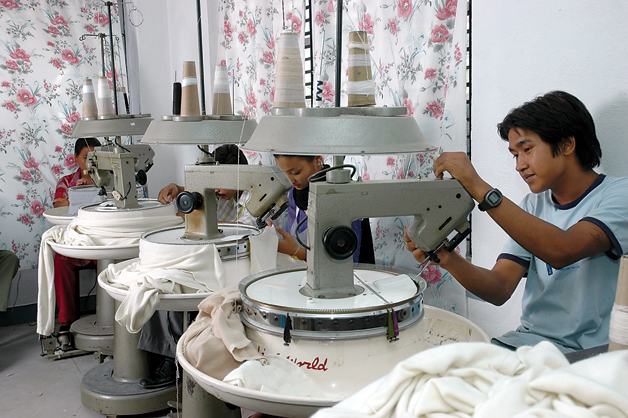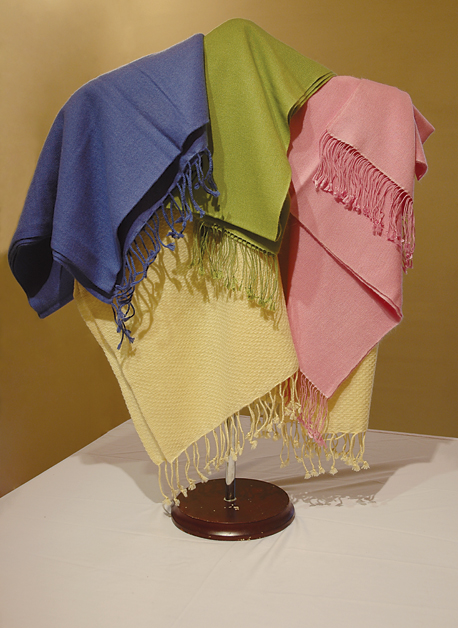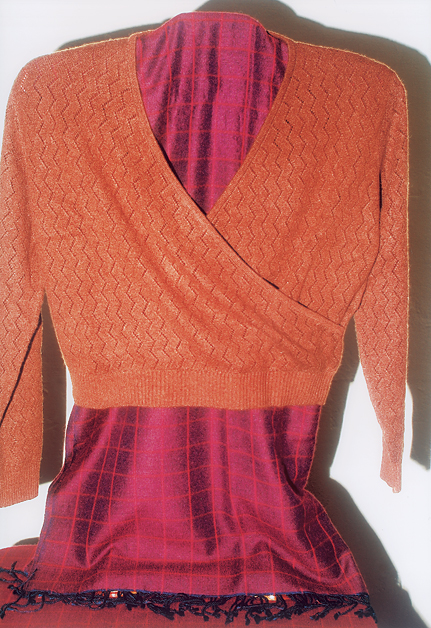
Pashmina
Once considered a status symbol owned by a select few, pashmina has risen in its popularity over the years and is now a must-have for stylish city-dwellers.
The story of pashmina is remarkable to say the least, beginning in one of the world’s most desolate areas and making its way into high fashion boutiques and the closets of the wealthy. For centuries in Nepal, it was considered an extravagance, to be flaunted only by the elite, treasured and passed down from generation to generation. Among the rarest natural fibers to exist and one perpetually ‘in style’, pashmina has persisted in its popularity to become one of the most sought-after fabrics in the fashion industry today.
 Pashmina derives its name from the word “pashm” which translates to “wool” in the Persian language, though people in the West might be more familiar with the term “cashmere”. This, in turn, is in reference to the Cashmir goat from the Kashmir region in India – the source of the fiber, and believed to be the area where the tradition of making pashmina shawls originated. Stories indicate that in the early 1800s, it was the French, under Napoléon Bonaparte, who came to India on a conquest and fell in love with these goods, so much that they stocked up on several thousand Kashmiri shawls and had them shipped off to Europe. Napoléon’s wife, Empress Josephine of France then initiated a full-fledged cashmere trade and in the ensuing years, Victorian England adopted the trend as well. Pashmina was now firmly established in high society as a wardrobe staple for the affluent.
Pashmina derives its name from the word “pashm” which translates to “wool” in the Persian language, though people in the West might be more familiar with the term “cashmere”. This, in turn, is in reference to the Cashmir goat from the Kashmir region in India – the source of the fiber, and believed to be the area where the tradition of making pashmina shawls originated. Stories indicate that in the early 1800s, it was the French, under Napoléon Bonaparte, who came to India on a conquest and fell in love with these goods, so much that they stocked up on several thousand Kashmiri shawls and had them shipped off to Europe. Napoléon’s wife, Empress Josephine of France then initiated a full-fledged cashmere trade and in the ensuing years, Victorian England adopted the trend as well. Pashmina was now firmly established in high society as a wardrobe staple for the affluent.
Producing areas were thus initially confined to the Himalayan region, chiefly in the Gobi Desert area of Mongolia, and Nepal’s role in this trade was significant right from the beginning. The goats, of a special breed that is prevalent only in high altitudes, are found aplenty in the mountainous regions of the country. The under-fleece of the goat’s fur, that is meant to protect it against the harsh weather conditions, is of a particularly supple texture, and it is this inner wool that goes into the making of pashmina. In the past, nomadic tribesmen would comb it out, by hand, to smoothen it. “The scarcity of this fiber is made clear by the fact that it requires wool from three goats to produce enough yarn
for one sweater,” informs Padam Pun of Himalayan Cashmere, a pashmina manufacturer in Lazimpat. While newer blends have been created, it is still the pure 100% pashmina that is valued the most.
What is most enticing is probably the warmth of the fabric, despite its delicate appearance. The fibers are between 13 to 17 microns in diameter, and when constructed into fine yarns, they make for highly-adaptable and elegant accessories. While natural pashmina would come in either grey, brown or white, it can be dyed into any desired color – available in bright accents of blue, green and pink for the stylish. But, of course, it is still the pastel hues that are most attractive. Shawls, stoles, scarves, sweaters and mufflers in pashmina have been in circulation for ages and women especially can be seen donning these at parties. The fabrics can be accentuated with beading or embroidery or the latest fad – graduated colors. The list is growing to include shirts, blankets, gloves and hats made of the material; the Ardor Knitwears showroom at Hotel Ambassador even carries a range of interesting decorative items like cushion covers and hot water bag cases.
 Pashmina business reached its peak in the mid 90s, and soon, it was blended with other fabrics to achieve variety. The silk-pashmina combination was developed first in Nepal; not only did it enhance the sheen and durability of the fiber, but it also brought about a marked reduction in prices, thereby making it affordable to a larger group of people. This new blend rose to popularity around the world, and in the years between 1999 and 2000, textile industries in the country that were practically closed down because of lack of business, were instantly rejuvenated and back on their feet. But despite its staying power, the cost of pashmina garments is
Pashmina business reached its peak in the mid 90s, and soon, it was blended with other fabrics to achieve variety. The silk-pashmina combination was developed first in Nepal; not only did it enhance the sheen and durability of the fiber, but it also brought about a marked reduction in prices, thereby making it affordable to a larger group of people. This new blend rose to popularity around the world, and in the years between 1999 and 2000, textile industries in the country that were practically closed down because of lack of business, were instantly rejuvenated and back on their feet. But despite its staying power, the cost of pashmina garments is
expected to remain more or less the same. “Pashmina will always be a luxury item,” says Purushottam Pokharel, one of the proprietors of the Fewa Pashmina showroom in Sanepa. “It requires too much input and selective conditions to be sold cheaply.” Regardless of this, the demand for pashmina products has been steadfast over time, with more and more people embracing its pleasant, luxurious feel and light-weight quality.
A combination of traditional workmanship and stylish sublimity, a piece of history interwoven into elegant designs, pashmina is perhaps one of the warmest, softest, most exquisite indulgences money could buy.
 FIBER PRODUCTION
FIBER PRODUCTION
There are five basic steps to making pashmina – Collection, Sorting, Dehairing, Spinning and Weaving. The Asiatic goats (Capra Hircus Laniger) produce a double fleece, comprising of a coarse protective outer coating and a softer inner coating. These mammals usually molt during the spring season for several weeks, and it is then that the wool is collected, mostly by raking a comb through the fleece and pulling tufts of hair from the animal. Hand-sorting occurs next, where
the material is combed through again to remove the coarse hairs. “After sorting, the fiber must be washed to remove grease, dirt and any vegetable matter that it might have gathered during the extraction of the wool,” explains Ram G. Singh of Ardor Knitwears.
The scoured material is then de-haired, which again attempts to remove the small particles of coarse hair that remain. This is more or less a mechanical process, meant to ensure that the “cashmere” so obtained is completely pure. The outer coating isn’t discarded immediately, however; it can be used to make brushes and interlinings. Once free of all impurities, the fiber is ready to be spun into yarns and woven into shawls or other products on handlooms or knitted into sweaters. It can also be combined on a warp with spun silk (generally in a 70% pashmina to 30% silk ratio) and other materials. The twill design is the standard weave for pashmina, while there are other options like diamond or herringbone.
 China remains the largest producer of raw pashmina, followed by other Asian countries. The Nepali manufacturers import the threads from China, since our own production is meager and inadequate to meet with market requirements. Several countries in Europe as well as the United States have also made an attempt to rear goats on a commercial scale, though the climatic conditions of the Himalayan mountains cannot be duplicated, therefore resulting in a fiber that is similar to pashmina, but not quite as fine.
China remains the largest producer of raw pashmina, followed by other Asian countries. The Nepali manufacturers import the threads from China, since our own production is meager and inadequate to meet with market requirements. Several countries in Europe as well as the United States have also made an attempt to rear goats on a commercial scale, though the climatic conditions of the Himalayan mountains cannot be duplicated, therefore resulting in a fiber that is similar to pashmina, but not quite as fine.











